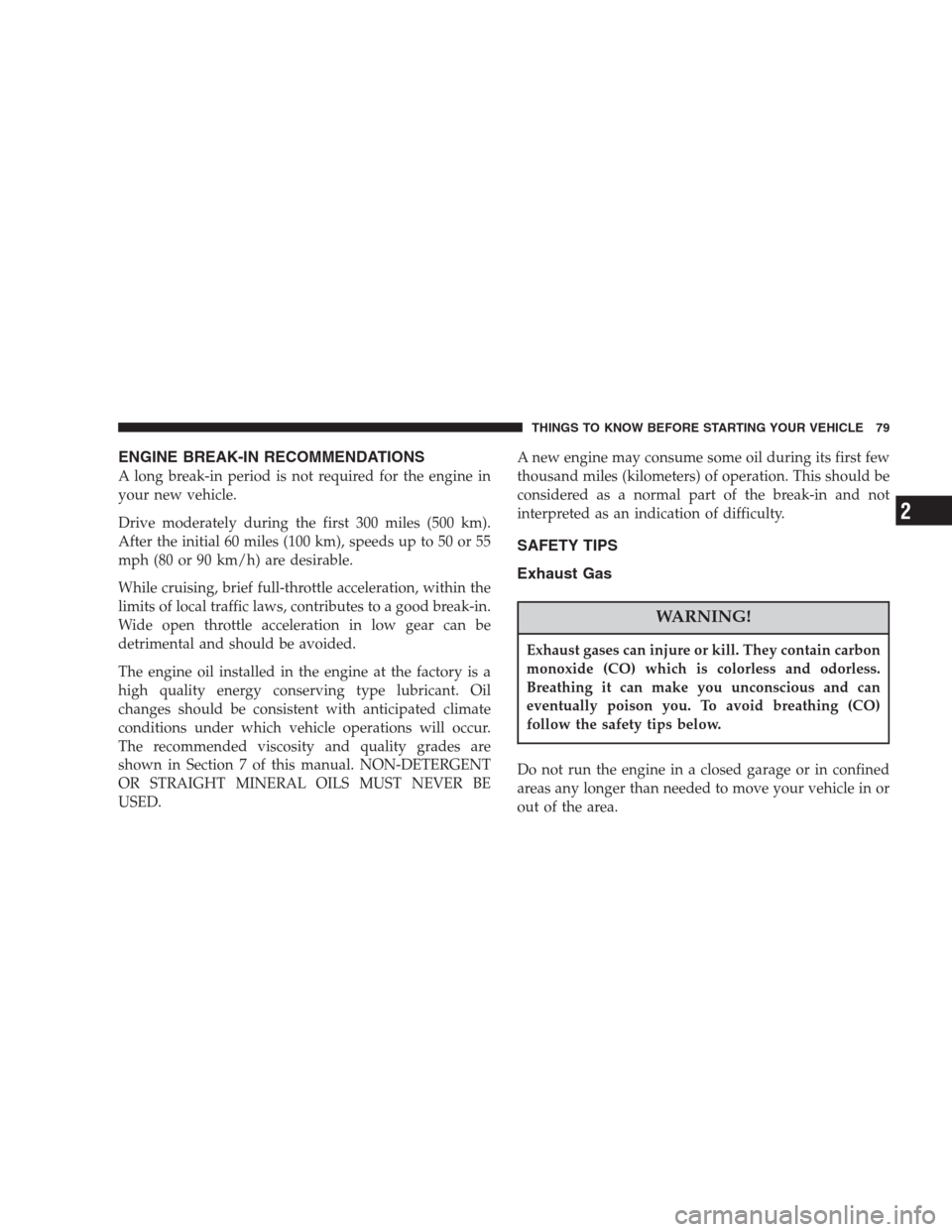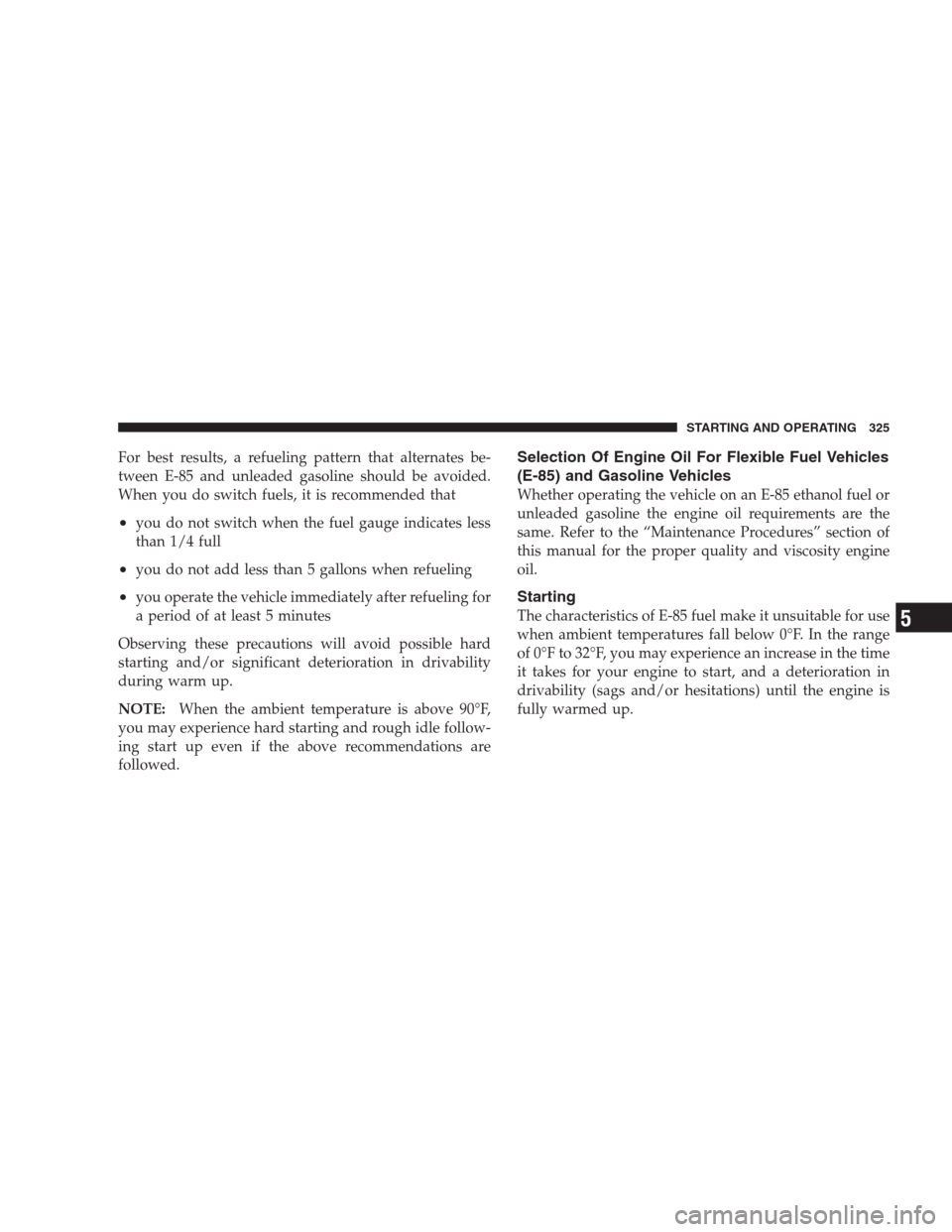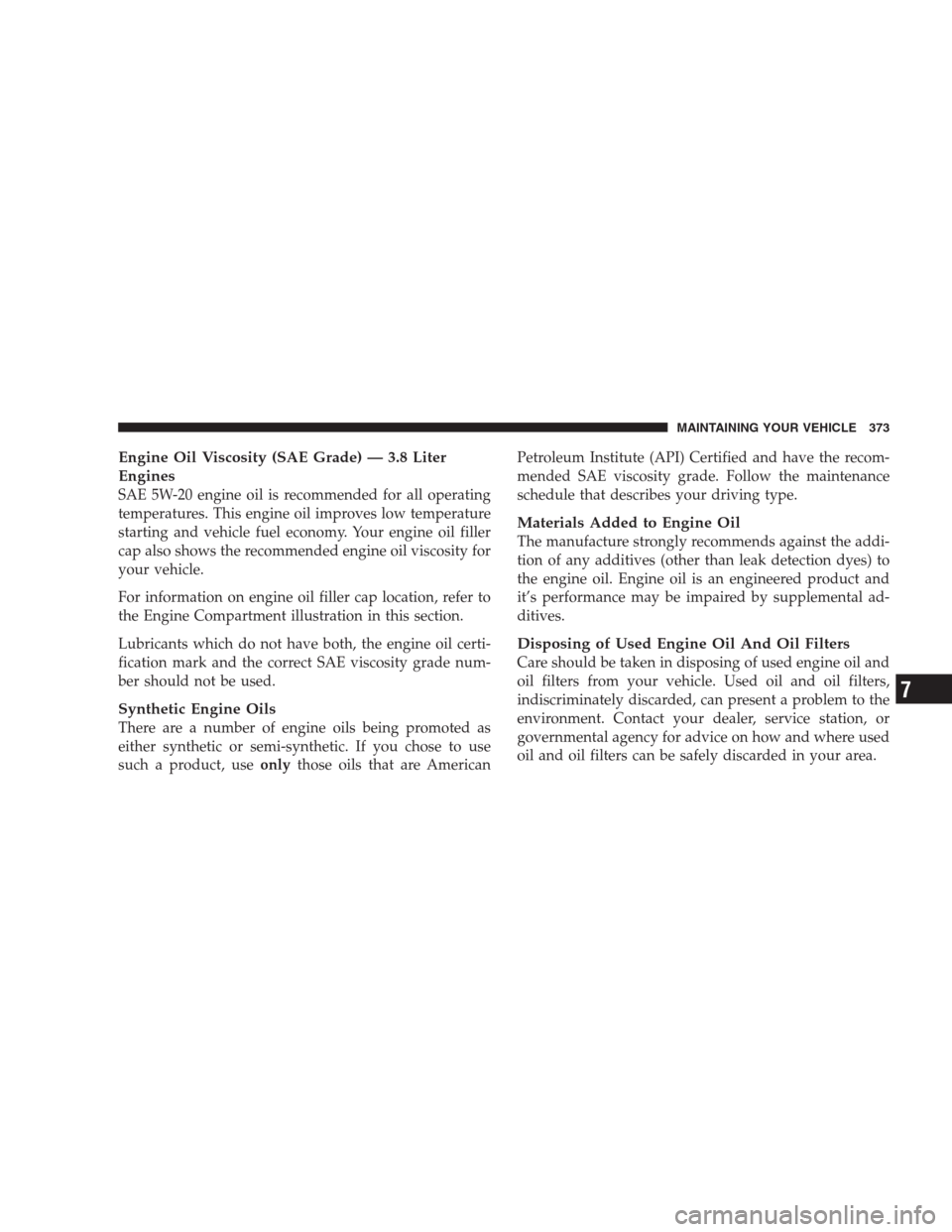Page 79 of 464

ENGINE BREAK-IN RECOMMENDATIONS
A long break-in period is not required for the engine in
your new vehicle.
Drive moderately during the first 300 miles (500 km).
After the initial 60 miles (100 km), speeds up to 50 or 55
mph (80 or 90 km/h) are desirable.
While cruising, brief full-throttle acceleration, within the
limits of local traffic laws, contributes to a good break-in.
Wide open throttle acceleration in low gear can be
detrimental and should be avoided.
The engine oil installed in the engine at the factory is a
high quality energy conserving type lubricant. Oil
changes should be consistent with anticipated climate
conditions under which vehicle operations will occur.
The recommended viscosity and quality grades are
shown in Section 7 of this manual. NON-DETERGENT
OR STRAIGHT MINERAL OILS MUST NEVER BE
USED.A new engine may consume some oil during its first few
thousand miles (kilometers) of operation. This should be
considered as a normal part of the break-in and not
interpreted as an indication of difficulty.
SAFETY TIPS
Exhaust Gas
WARNING!
Exhaust gases can injure or kill. They contain carbon
monoxide (CO) which is colorless and odorless.
Breathing it can make you unconscious and can
eventually poison you. To avoid breathing (CO)
follow the safety tips below.
Do not run the engine in a closed garage or in confined
areas any longer than needed to move your vehicle in or
out of the area.
THINGS TO KNOW BEFORE STARTING YOUR VEHICLE 79
2
Page 325 of 464

For best results, a refueling pattern that alternates be-
tween E-85 and unleaded gasoline should be avoided.
When you do switch fuels, it is recommended that
•you do not switch when the fuel gauge indicates less
than 1/4 full
•you do not add less than 5 gallons when refueling
•you operate the vehicle immediately after refueling for
a period of at least 5 minutes
Observing these precautions will avoid possible hard
starting and/or significant deterioration in drivability
during warm up.
NOTE:When the ambient temperature is above 90°F,
you may experience hard starting and rough idle follow-
ing start up even if the above recommendations are
followed.
Selection Of Engine Oil For Flexible Fuel Vehicles
(E-85) and Gasoline Vehicles
Whether operating the vehicle on an E-85 ethanol fuel or
unleaded gasoline the engine oil requirements are the
same. Refer to the “Maintenance Procedures” section of
this manual for the proper quality and viscosity engine
oil.
Starting
The characteristics of E-85 fuel make it unsuitable for use
when ambient temperatures fall below 0°F. In the range
of 0°F to 32°F, you may experience an increase in the time
it takes for your engine to start, and a deterioration in
drivability (sags and/or hesitations) until the engine is
fully warmed up.
STARTING AND OPERATING 325
5
Page 372 of 464
American Petroleum Institute (API) Engine Oil
Identification Symbol
This symbol means that the oil has
been certified by the American
Petroleum Institute (API). The
manufacturer only recommends
API Certified engine oils.
Engine Oil Viscosity (SAE Grade) — 4.0 Liter
Engines
The proper SAE viscosity grade of engine oil should be
selected based on the following recommendation and be
within the operating temperature shown in the engine oil
viscosity chart.•SAE 10W-30engine oil is preferred. SAE 5W-30 engine
oil is allowed during cold weather only to improve
cold weather starting.
Lubricants which do not have both, the engine oil certi-
fication mark and the correct SAE viscosity grade num-
ber should not be used.
372 MAINTAINING YOUR VEHICLE
Page 373 of 464

Engine Oil Viscosity (SAE Grade) — 3.8 Liter
Engines
SAE 5W-20 engine oil is recommended for all operating
temperatures. This engine oil improves low temperature
starting and vehicle fuel economy. Your engine oil filler
cap also shows the recommended engine oil viscosity for
your vehicle.
For information on engine oil filler cap location, refer to
the Engine Compartment illustration in this section.
Lubricants which do not have both, the engine oil certi-
fication mark and the correct SAE viscosity grade num-
ber should not be used.
Synthetic Engine Oils
There are a number of engine oils being promoted as
either synthetic or semi-synthetic. If you chose to use
such a product, useonlythose oils that are AmericanPetroleum Institute (API) Certified and have the recom-
mended SAE viscosity grade. Follow the maintenance
schedule that describes your driving type.
Materials Added to Engine Oil
The manufacture strongly recommends against the addi-
tion of any additives (other than leak detection dyes) to
the engine oil. Engine oil is an engineered product and
it’s performance may be impaired by supplemental ad-
ditives.
Disposing of Used Engine Oil And Oil Filters
Care should be taken in disposing of used engine oil and
oil filters from your vehicle. Used oil and oil filters,
indiscriminately discarded, can present a problem to the
environment. Contact your dealer, service station, or
governmental agency for advice on how and where used
oil and oil filters can be safely discarded in your area.
MAINTAINING YOUR VEHICLE 373
7
Page 412 of 464
FLUIDS, LUBRICANTS AND GENUINE PARTS
Engine
Component Fluids, Lubricants and Genuine Parts
Engine Coolant Mopar�Antifreeze/Coolant 5 Year/100,000 Mile Formula HOAT (Hybrid Or-
ganic Additive Technology) or equivalent
4.0 Liter Engine Oil Use API Certified SAE 10W-30 engine oil, refer to oil viscosity chart for cor-
rect SAE grade meeting DaimlerChrysler Material Standard MS-6395.
3.8 Liter Engine Oil Use API Certified SAE 5W-20 engine oil. Refer to your oil filler cap for cor-
rect SAE grade, meeting DaimlerChrysler Material Standard MS-6395.
Spark Plugs Refer to the Vehicle Emission Control Information label in the engine com-
partment.
Oil Filter, 4.0/3.8 Liter Engines Mopar�5281090 or equiv.
Fuel Selection 89 Octane
412 MAINTAINING YOUR VEHICLE
Page 456 of 464

Mirrors................................ 88
Automatic Dimming..................... 88
Electric Remote........................ 90
Exterior Folding........................ 89
Heated.............................. 91
Memory............................. 127
Outside.............................. 89
Rearview............................. 88
Vanity............................... 91
Modifications/Alterations, Vehicle............. 7
Monitor, Tire Pressure System............... 308
Mopar Parts.........................368,441
Multi-Function Control Lever............... 134
Navigation System....................146,232
New Vehicle Break-In Period................ 79
Occupant Restraints....................... 40
Octane Rating, Gasoline (Fuel).............. 318Odometer............................. 184
Oil, Engine.........................369,412
Capacity............................ 411
Change Interval....................... 371
Checking............................ 369
Disposal............................ 373
Filter............................374,412
Filter Disposal........................ 373
Identification Logo..................... 372
Materials Added to..................... 373
Recommendation....................371,411
Synthetic............................ 373
Viscosity.......................372,373,411
Onboard Diagnostic System..............366,367
Opener, Garage Door (HomeLink�) ........... 154
Overdrive............................. 274
Overhead Console....................... 153
Overhead Travel Information Center.......... 153
Overheating, Engine...................180,345
456 INDEX